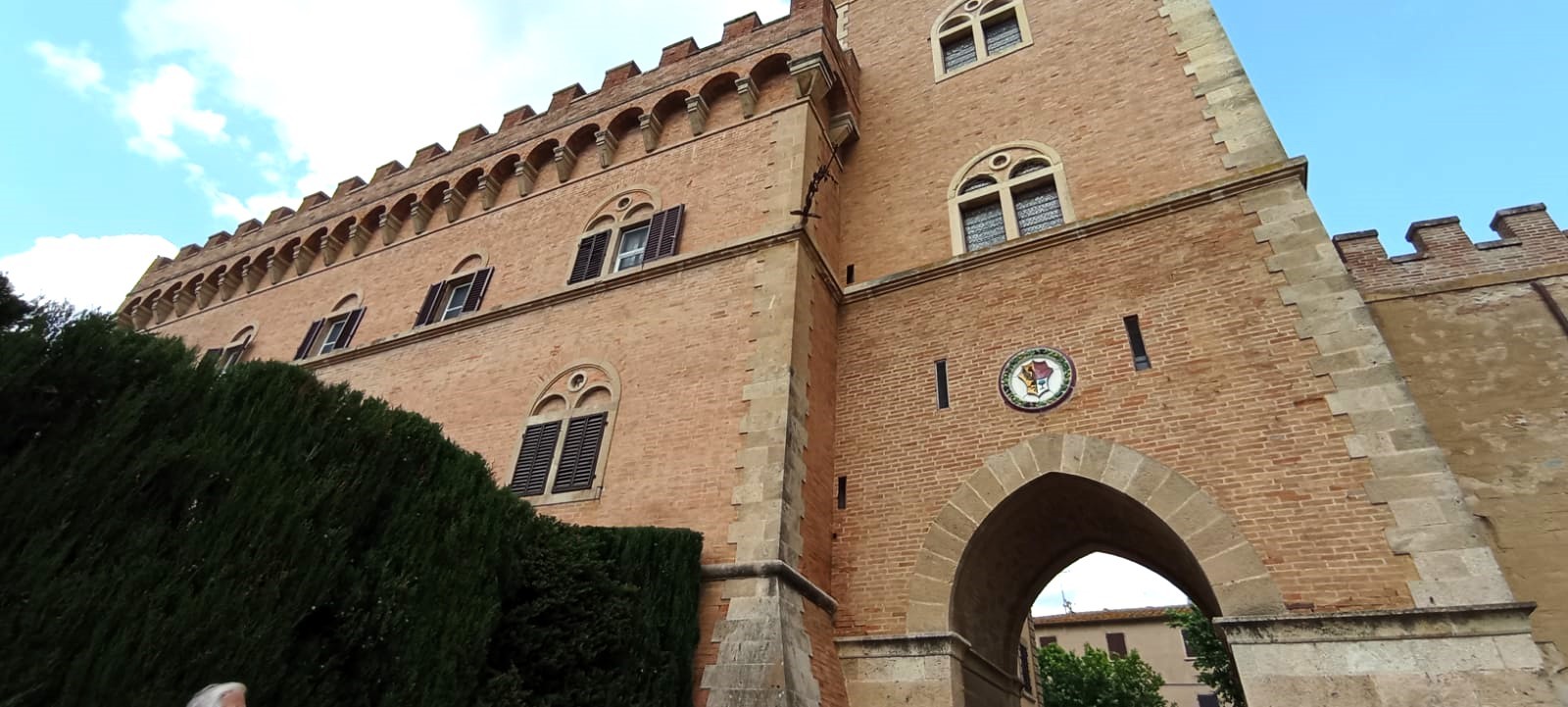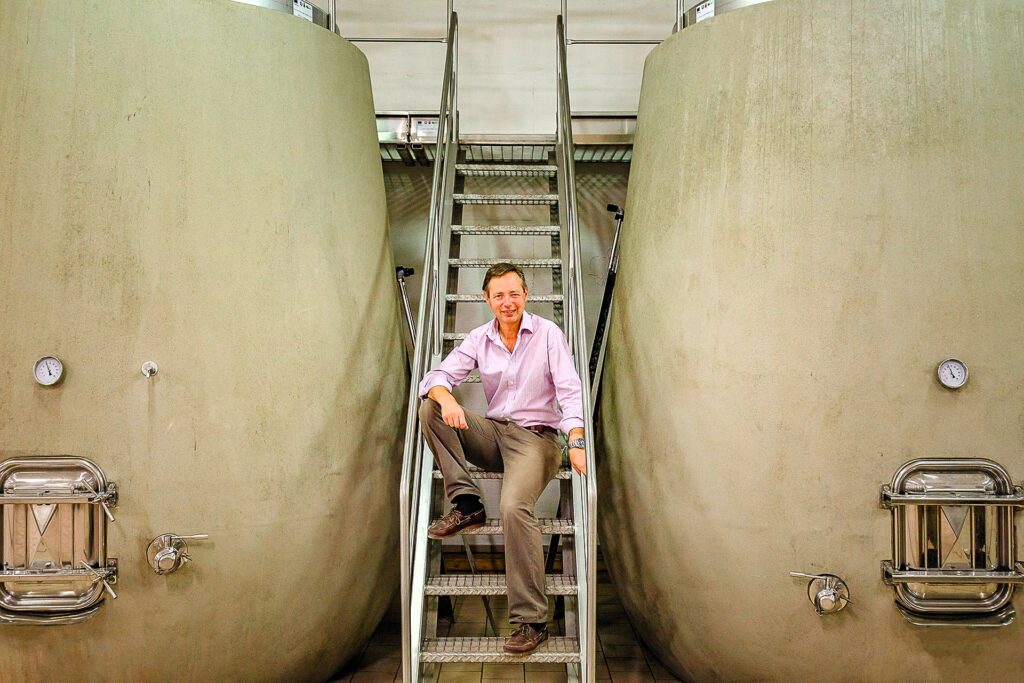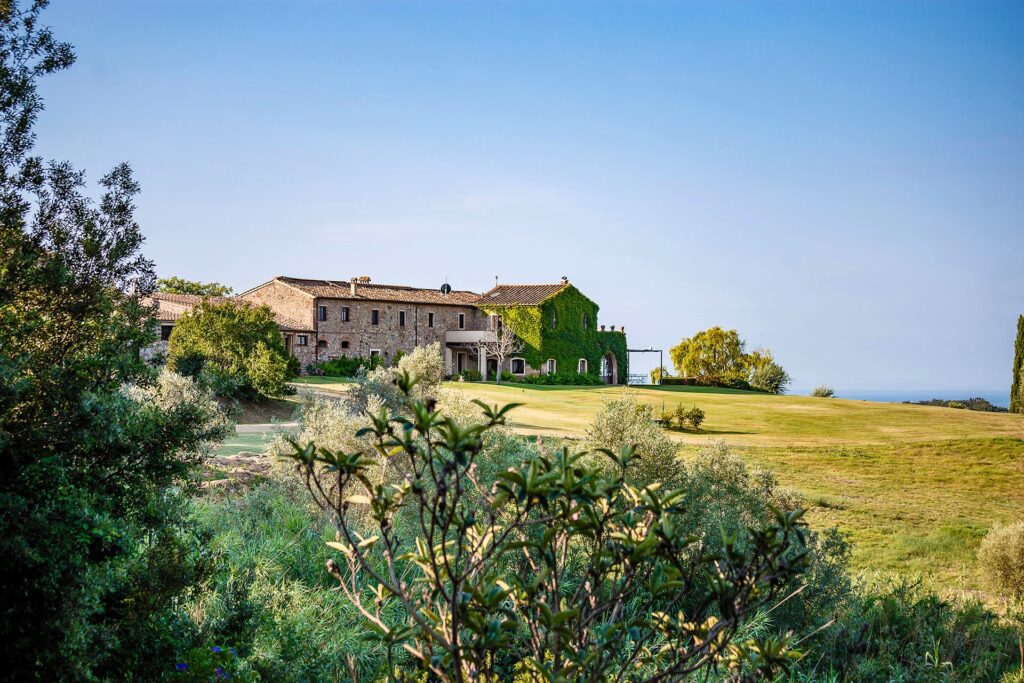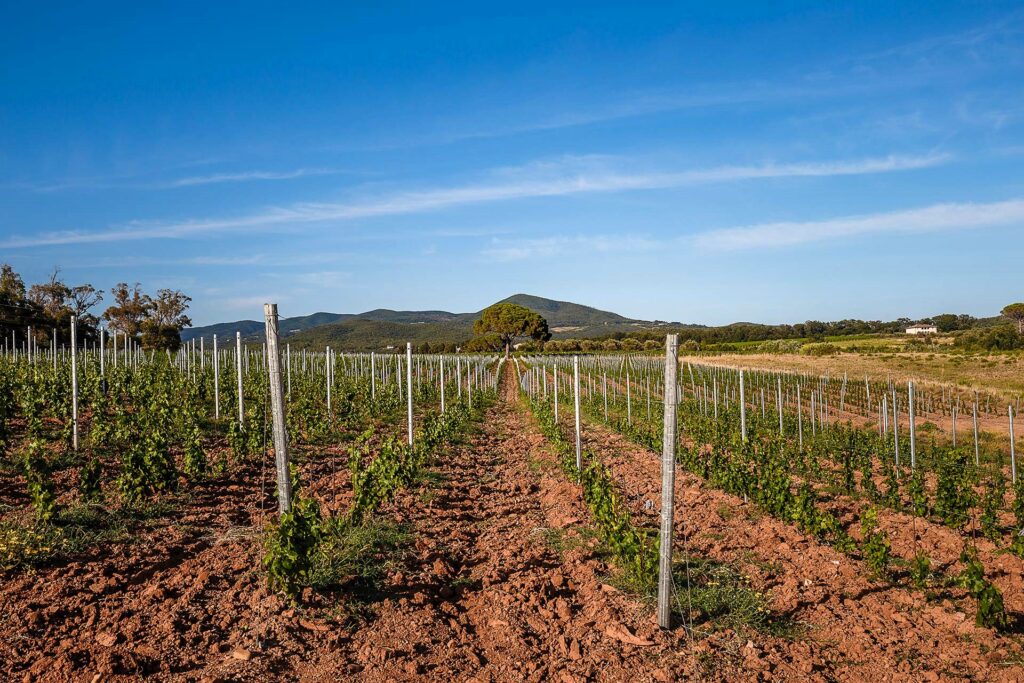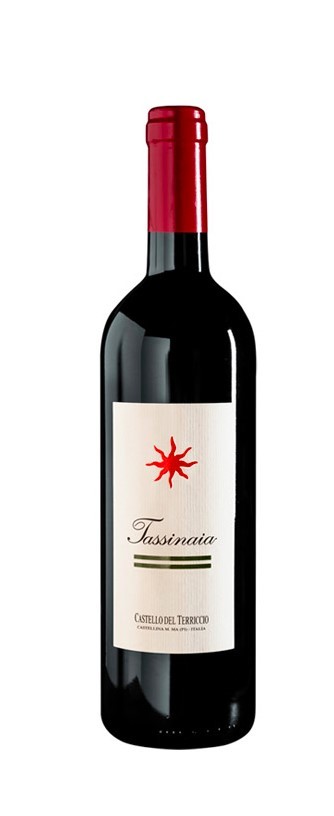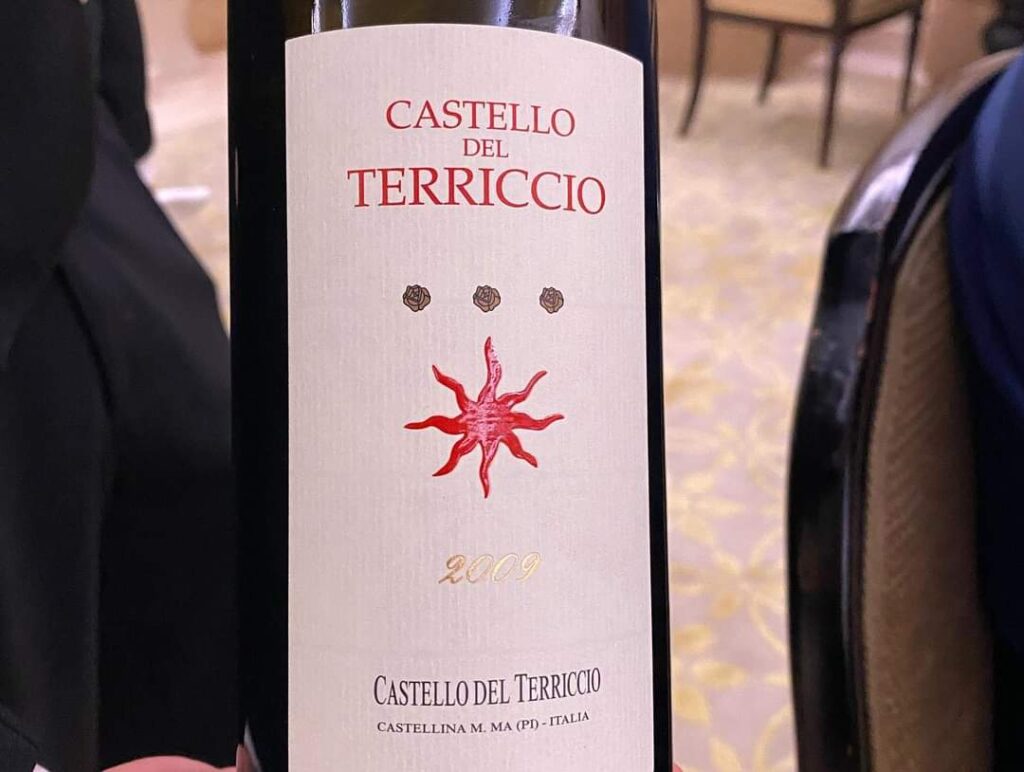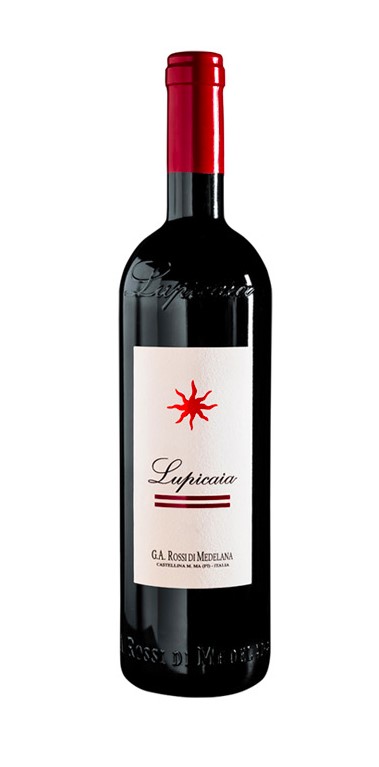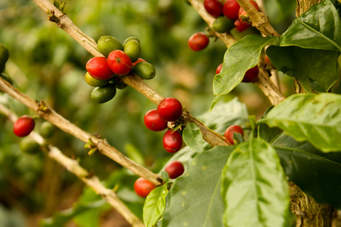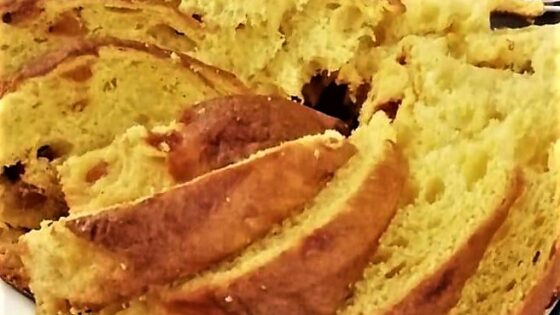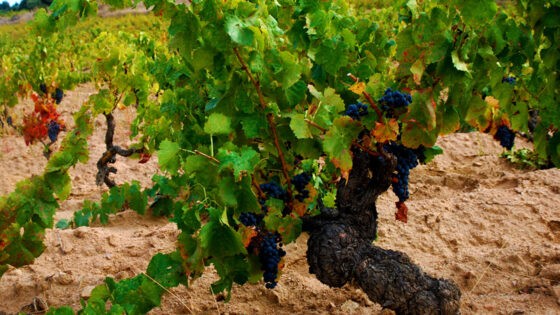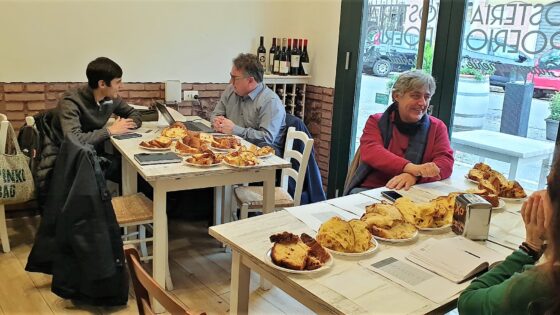Una tenuta di 1.500 ettari per secoli feudo agricolo è oggi cantina di straordinari Supertuscans, primo tra tutti il celebre Lupicaia. Tutto questo grazie alla lungimiranza di Gian Annibale Rossi di Medelana ed alla bravura dell’enologo Carlo Ferrini.
Oggi il testimone è passato al nipote Vittorio Piozzo di Rosignano Rossi di Medelana, nel solco della continuità e di una tradizione millenaria.
Il sole etrusco, simbolo distintivo della cantina e dei suoi pregiati vini, testimonia la presenza di insediamenti risalenti all’800 a.C. già dediti alla viticoltura ed all’estrazione mineraria. Situata a soli 10 chilometri dal mare e poco più di 20 chilometri a nord di Bolgheri, la proprietà si estende su un unico appezzamento di 1.500 ettari. Oggi la tenuta comprende circa 65 ettari di vigneto, uliveti, pascoli con allevamenti allo stato brado, boschi e colture di cereali: un’immensa oasi con oltre mille anni di storia.
Nel Medioevo qui fu costruito il Castello di Doglia, noto come del Terriccio, fondamentale come torre d’avvistamento e rifugio in caso di incursioni saracene. La storia del Castello è legata alle sorti della dinastia pisana dei Gaetani. Ugone, il capostipite, secondo duca di Gaeta, ebbe in feudo la Contea di Terriccio nel 962 dall’imperatore Ottone I.
Si susseguono diversi secoli legati alla famiglia Gaetani, influente famiglia della Repubblica Marinara di Pisa. Tra il XIII ed il XIV il borgo risulta ceduto in enfiteusi dall’arcidiocesi di Pisa e rimane in suo possesso per circa cinque secoli. In questo periodo il castello assume sempre più la connotazione di feudo agricolo, con diverse colture e allevamenti.
L’ultimo Gaetani di cui si ha notizia a Pisa è il conte Alessandro: dopo la sua morte (1823) la tenuta di Terriccio fu aggiudicata ad asta pubblica nel 1811 a Antonio Maria Bustelli, che la rivendette nel 1824 ai Principi di Polonia Poniatowski che ne restarono proprietari fino alla Prima Guerra Mondiale.
Successivamente il borgo divenne proprietà dei Marchesi Serafini Ferri che ne sostennero lo sviluppo: l’intera tenuta era una vera e propria cittadina, composta da circa 60 famiglie che lavoravano in mezzadria.
Nel 1975 con il passaggio a Gian Annibale Rossi di Medelana, erede della famiglia Serafini Ferri, arrivò una vera svolta con l’idea di perseguire la viticoltura produzione di vino di alta qualità. Oggi, si conserva l’immenso patrimonio di colture e allevamenti che da tempo immemore caratterizzano questi luoghi.
La rivoluzione in vigna
L’ispirazione per la rivoluzione in vigna arrivò da oltralpe. Gian Annibale Rossi di Medelana, conoscendo i vini di Bordeaux, decise di sostituire il Sangiovese con vitigni francesi. Per realizzare questo progetto, scelse un compagno di viaggio straordinario: Carlo Ferrini, che avrebbe seguito le vicende dell’azienda agricola per oltre 30 anni.
Tra la fine degli anni ’80 e l’inizio degli anni ’90, arrivarono vitigni come lo Chardonnay, il Sauvignon Blanc, il Cabernet Sauvignon, il Cabernet Franc e il Merlot, seguiti successivamente da Syrah e Petit Verdot. Il clima mediterraneo, le brezze marine e la ricchezza di minerali del sottosuolo contribuirono a dare risultati incoraggianti fin da subito.
Il primo vino nacque da un terreno chiamato Sassinaia, ovviamente per la conformazione geologica. Così il vino, per evitare assonanze con il famoso supertuscan di Bolgheri, venne battezzato Tassinaia. È il 1992.
L’anno seguente uscì la prima annata di quello che ormai è un grande classico e simbolo della cantina: il Lupicaia, che prende il nome dalla collina dove si avvistavano lupi. Infine, sette anni più tardi, nel 2000, uscì il Castello del Terriccio.
Gian Annibale Rossi di Medelana scomparve purtroppo nel 2019 e oggi la proprietà e la guida dell’azienda sono passate all’unico nipote, Vittorio Piozzo di Rosignano Rossi di Medelana. Oggi porta avanti orgogliosamente l’azienda, un mondo prezioso ed unico, senza tempo, fatto di gesti e persone, come ben descrive nelle sue parole: “Fare il viale alberato la sera è come fare un salto indietro nel tempo. Le strade non sono illuminate. Alcuni operai dell’azienda, che sono figli o nipoti di ex mezzadri, abitano ancora qui. Come il nipote dell’ex bracconiere, poi diventato guardia venatoria. Ci piace questa continuità delle persone».
La degustazione
Tassinaia
Cabernet Sauvignon e Merlot, da vigne disposte su terreni ricchi di pietre e fossili, tra i 100 e i 300 metri di altitudine ed esposizione a Sud/Sud-Ovest.
La vinificazione avviene in acciaio a temperatura controllata, con macerazione delle uve per circa 9-12 gg per il Merlot e di 12-15 giorni per il Cabernet Sauvignon. Durante le fermentazioni successivi rimontaggi e délestage.
Segue l’affinamento a masse separate per varietà, in tonneau di rovere francese di secondo e terzo passaggio per 16 mesi. Dopo essere stato assemblato e imbottigliato riposa altri 12 mesi in bottiglia prima di essere commercializzato.
La 2018 ha riportato alla normalità le condizioni climatiche, con un numero di giorni con temperature sotto lo zero sufficiente affinché le viti iniziassero il loro riposo invernale. La primavera è stata piovosa con precipitazioni maggiori rispetto alle annate precedenti. L’estate è stata calda e asciutta, le temperature sono state più alte della media stagionale, ma le notti più fresche hanno permesso alle viti di recuperare e preservare gli aromi e l’acidità.
Tassinaia 2018. Rubino piuttosto trasparente. Diretto e intenso, ricco di frutto, ciliegia, prugna, mirtillo, poi macchia mediterranea, lentisco, alloro, spezie scure, liquirizia, tè nero. Sorso coerente, succoso, con echi speziati. Acidità contenuta, tannini sottili, fini, perfettamente integrati, in un bel gioco di rimandi, con la mineralità che chiude, per un finale lungo e persistente.
Castello del Terriccio
Syrah e Petit Verdot. Il Syrah proviene dal terreno “Saluccio”: terreno sabbioso, forte presenza di ghiaia grossolana, buona presenza di sostanza organica, macro e microelementi, esposizione est-ovest. Il Petit Verdot dal terreno “Addis”: terreno calcareo argilloso con presenza di scheletro roccioso, esposizione sud- est.
La perfetta inclinazione verso il mare mediterraneo, un riflesso del sole unico, la leggera brezza della costa e l’abbondanza di luce solare promuovono una maturazione unica ed esclusiva.
La vinificazione avviene in acciaio a cappello aperto a temperatura controllata, con macerazione delle uve, per circa 20 giorni con délestage giornalieri. L’affinamento avviene in tonneau di rovere francese di primo e secondo passaggio per un periodo di circa 22 mesi e successivamente il vino viene assemblato ed imbottigliato.
L’annata 2017 è stata una delle più calde e siccitose degli ultimi anni con un inverno particolarmente mite e con piogge normali. Il germogliamento è avvenuto in anticipo di quasi due settimane. Il ciclo vegetativo delle vigne è stato accompagnato da tempo caldo con una piovosità scarsa già da marzo, appena interrotto da un improvviso calo delle temperature a fine aprile. Già da maggio il caldo e la siccità sono tornati limitando lo sviluppo vegetativo e la dimensione dei grappoli, nonostante la fioritura si sia svolta in ottime condizioni. Luglio e agosto sono stati molto caldi ed hanno visto la quasi assenza di piogge, raffrescati dalle temperature notturne.
Castello del Terriccio 2017. Frutti di bosco, rosa, macchia mediterranea, declinati in un ensemble di grande eleganza. Poi ancora grafite, liquirizia dolce e richiami balsamici. Sorso compatto e dinamico, con cenni di tabacco da pipa. Largo ed avvolgente, con tannini setosi, chiude con un finale molto persistente.
Castello del Terriccio 2009. Nonostante i 14 anni dalla vendemmia, riporta un colore rubino vivido e luminoso e profumi ricchi di frutto, mirtillo, ciliegia, poi sottobosco, una ricca speziatura, corteccia, foglie secche, note boschive, elicriso. Il sorso è largo e ampio, succoso con un ingresso solenne. Il tannino tende ad emergere per poi rientrare in un quadro vibrante e al contempo di antico fascino. Vino emozionante.
Castello del Terriccio 2008. Percorso evolutivo ben diverso dalla 2009: qui il colore vira verso il granato ed anche il frutto è più maturo. Tabacco, cuoio, spezie, cardamomo, china, grafite e un cenno di cioccolato. Un quadro aromatico più placido e pacato, ma che trova invece al sorso una inattesa verticalità. Acidità perentoria, tannini finissimi ed una chiusura lievemente sapida, rifiniscono una beva di grande pregio.
Lupicaia
Cabernet Sauvignon al 90%, Petit Verdot 10%. Le uve di Cabernet Sauvignon sono coltivate sull’omonimo terreno – luogo dei lupi – con caratterizzazione calcareo-sabbiosa e presenza di scheletro roccioso. L’ esposizione è a Sud. La produttività è bassa, anche in conseguenza dell’età dei vigneti, di oltre 30 anni.
La vendemmia avviene rigorosamente a mano. Dopo una prima selezione in vigna al momento della raccolta manuale, le uve del Lupicaia vengono accuratamente selezionate una seconda volta all’arrivo in cantina sul tavolo di cernita.
Dopo le uve vengono diraspate delicatamente e pressate avendo cura di non rompere la buccia degli acini. La fermentazione avviene in acciaio a cappello aperto a temperatura controllata, con macerazione delle uve per ca. 20 giorni e con délestage giornalieri. Segue l’affinamento in tonneau di rovere francese nuovi per circa 22 mesi.
L’andamento climatico della 2015 è stato caratterizzato da un inverno ed un inizio primavera con precipitazioni abbondanti che ha permesso l’accumulo di importanti riserve idriche. Il germogliamento è risultato anticipato rispetto alla scorsa annata, così come la fioritura iniziata dopo la metà di maggio, a cui è seguita un’ottima allegagione. Da un punto vista sanitario i vigneti non hanno presentato problemi particolari di fitopatie. Si è registrato un anticipo dell’invaiatura di circa dieci giorni. Dopo un aprile – maggio altalenanti, dal mese di giugno a quello di luglio si sono registrate alte temperature ben al di sopra della media stagionale con forte carenza di piogge, dopo la metà di agosto la situazione si è nuovamente modificata con provvidenziali precipitazioni e il conseguente abbassamento delle temperature, ripristinando le condizioni ideali per il prosieguo del ciclo vegetativo della vite, riportando lo sviluppo e la conseguente maturazione degli acini a condizioni ottimali.
Lupicaia 2015. Rubino concentrato. Intenso, articolato, elegante. toni floreali su frutti di bosco maturi. Caramella alla violetta, rosa, macchia mediterranea, pepe, note balsamiche, infine tabacco biondo. Sorso ieratico, severo, con evidenti margini di evoluzione nel tempo. Tannini di notevole pregio ed un complessivo equilibrio che lascia spazio alla componente acido-sapida sul finale.
La 2014 è stata una annata alquanto insolita in tutta Italia, ma sicuramente mal giudicata per quanto riguarda la Maremma. Abbiamo avuto abbondanti piogge, ma non così eccessive come in altre zone d’Italia. L’inverno è stato abbastanza mite, mentre la primavera, iniziata in ritardo e con temperature più rigide rispetto alla norma stagionale, ha contribuito a tardare l’avvio vegetativo. A maggio la vegetazione è esplosa con l’arrivo delle temperature più calde.
L’estate è stata caratterizzata da giornate di sole e temperature nelle medie fino a inizio luglio. Dalla prima decade di luglio si sono verificate alcune perturbazioni che hanno portato a precipitazioni e all’abbassamento delle temperature, decretando già a metà agosto la fine dell’estate. Il vento di tramontana a inizio settembre ha consentito alle uve di asciugarsi e di maturare lentamente. L’andamento dell’annata si avverte molto nel vino per il grado alcolico contenuto ma soprattutto per le note speziate e la grande componente aromatica che rendono piacevole il vino già in età giovane.
Lupicaia 2014. Colpisce in prima battuta il timbro floreale, che prevale sulla frutta fresca, prugna e mirtilli, seguito da note balsamiche di cardamomo ed after-eight, in un piacevole chiaroscuro. Sorso suadente ed elegante, con una progressione estesa, una acidità magistralmente calibrata in equilibrio con i tannini. Sorso con una bella tensione ed uno straordinario nitore sul finale.
La 2011 è annoverata come una delle migliori annate del 2000. L’inverno è stato rigido con temperature al di sotto della media stagionale. La primavera, iniziata in anticipo, con temperature miti e un ottimo apporto idrico, hanno favorito uno sviluppo vegetativo dei vigneti ottimale. Le temperature estive sono sempre state nella media stagionale con un’ottima escursione termica tra giorno e notte.
Lupicaia 2011. Fiori appassiti, rosa, macchia mediterranea, balsamicità mentolata, mineralità. Eleganza composta da leggerezza e rigore. Sorso dal profilo solenne e potente, con un’acidità spiccata che imbriglia e conduce la beva. Tannini setosi. Un vino che esprime una vitalità incredibile, nonostante i 12 anni alle spalle e lascia intendere ancora una lunga prospettiva di evoluzione.
CASTELLO DEL TERRICCIO – ENGLISH VERSION
A story like no other an etruscan sun, today an unmistakable symbol of the cellar and its wines, and numerous other finds testify to the presence of settlements since 800 BC. dedicated to both viticulture and mining.
“ The etruscan sun, the distinctive symbol of the winery and its fine wines, bears witness to the presence of settlements dating back to 800 BC. dedicated to viticulture and mining. Located just 10 kilometers from the sea and just over 20 kilometers north of Bolgheri, the property extends over a single plot of 1,500 hectares. Today, the estate includes about 65 hectares of vineyards, olive groves, pastures with wild breeding, woods and cereal crops: an immense oasis with over a thousand years of history.
In the Middle Ages, the Castle of Doglia was built here, known as del Terriccio, essential as a watchtower and refuge in the event of Saracen raids. The history of the castle is linked to the fate of the Gaetani dynasty from Pisa. Ugone, the progenitor, second duke of Gaeta, had the County of Terriccio as a fief in 962 from the emperor Otto I.
Several centuries follow one another linked to the Gaetani family, an influential family of the Maritime Republic of Pisa. Between the 13th and 14th centuries, the village was ceded in lease by the archdiocese of Pisa and remained in their possession for about five centuries. In this period the castle increasingly assumed the connotation of an agricultural feud, with various crops and farms.
The last Gaetani we know of in Pisa is Count Alessandro Gaetani: after his death (1823) the Terriccio estate was awarded at public auction in 1811 to Antonio Maria Bustelli, who resold it in 1824 to the Princes of Poland Poniatowski , who remained its owners until the First World War.
The property then passed to the Princes of Poland Poniatowski, who remained owners until the First World War.
Subsequently the village became the property of the Marquises Serafini Ferri who supported its development: the entire estate was a real town, made up of about 60 families who worked in sharecropping.
In 1975 with the transfer to Gian Annibale Rossi of Medelana, heir of the Serafini Ferri family, a real turning point came with the idea of pursuing viticulture for the production of high quality wine. Today, the immense heritage of crops and farms that have characterized these places since time immemorial is preserved.
The revolution in the vineyard
The inspiration for the revolution in the vineyard came from beyond the Alps. Gian Annibale Rossi of Medelana, knowing the wines of Bordeaux, decided to replace the Sangiovese with French vines. To carry out this project, he chose an extraordinary travel companion: Carlo Ferrini, who would follow the events of the farm for over 30 years.
In the late 1980s and early 1990s, grape varieties such as Chardonnay, Sauvignon Blanc, Cabernet Sauvignon, Cabernet Franc and Merlot arrived, followed later by Syrah and Petit Verdot. The Mediterranean climate, the sea breezes and the richness of minerals in the subsoil helped to give encouraging results right away.
The first wine was born from a land called Sassinaia, obviously due to the geological conformation. So the wine, to avoid similarities with the famous supertuscan of Bolgheri, was baptized Tassinaia. It's 1992.
The following year, the first vintage of what is now a great classic and symbol of the winery was released: the Lupicaia, which takes its name from the hill where wolves were sighted. Finally, seven years later, in 2000, Castello del Terriccio came out.
Gian Annibale Rossi of Medelana sadly passed away in 2019 and today the ownership and leadership of the company have passed to his only nephew, Vittorio Piozzo of Rosignano Rossi di Medelana. He proudly carries on the company, a precious and unique world, timeless, made up of gestures and people, as he well describes in his words: “Doing the tree-lined avenue in the evening is like stepping back in time. The streets are not lit. Some workers of the company, who are children or grandchildren of former sharecroppers, still live here. Like the nephew of the former poacher, who later became a guard and now a hunting guard. We like this continuity of people».
Tasting
Tassinaia Cabernet Sauvignon and Merlot, from vineyards arranged on soils rich in stones and fossils, between 100 and 300 meters above sea level. and South/South-West exposure.
The vinification takes place in steel at a controlled temperature, with maceration of the grapes for about 9-12 days for the Merlot and 12-15 days. for the Cabernet. During the following fermentations, pumping over and délestages.
This is followed by refinement in separate masses by variety, in second and third passage French oak tonneaux for 16 months. After being blended and bottled, it rests for another 12 months in the bottle before being marketed.
2018 brought the climatic conditions back to normal, with a number of days with sub-zero temperatures sufficient for the vines to begin their winter rest. Spring was rainy with more rainfall than in previous years. The summer was hot and dry, temperatures were higher than the seasonal average, but the cooler nights allowed the vines to recover and preserve their aromas and acidity.
Tassinaia 2018. Rather transparent ruby. Direct and intense, rich in fruit, cherry, plum, blueberry, then Mediterranean scrub, mastic, laurel, dark spices, liquorice, black tea. Consistent, juicy sip, with spicy echoes. Contained acidity, thin, fine, perfectly integrated tannins, in a nice play of references, with the minerality that closes, for a long and persistent finish.
Castello del Terriccio
Syrah and Petit Verdot. Syrah comes from the "Saluccio" soil: sandy soil, strong presence of coarse gravel, good presence of organic matter, macro and micro elements, east-west exposure. The Petit Verdot from the “Addis” soil: clayey-limestone soil with the presence of rocky skeleton, south-east exposure.
The perfect inclination towards the Mediterranean sea, a unique reflection of the sun, the light breeze from the coast and the abundance of sunlight promote a unique and exclusive maturation.
The vinification takes place in open cap steel at a controlled temperature, with maceration of the grapes, for about 20 days with daily délestages. Aging takes place in first and second passage French oak Tonneaux for a period of about 22 months and is subsequently blended and bottled.
The 2017 vintage was one of the hottest and driest in recent years with a particularly mild winter and normal rainfall.
The budding occurred almost two weeks early. The vegetative cycle of the vines was accompanied by hot weather with low rainfall as early as March, only to be interrupted by a sudden drop in temperatures at the end of April. As early as May, the heat and drought returned, limiting vegetative development and the size of the bunches, despite flowering taking place in excellent conditions. July and August were very hot and saw almost no rain, cooled by night temperatures.
Castello del Terriccio 2017. Berries, roses, Mediterranean scrub, declined in an ensemble of great elegance. Then again graphite, sweet licorice and balsamic hints. Compact and dynamic sip, with hints of pipe tobacco. Wide and enveloping, with silky tannins, it closes with a very persistent finish.
Castello del Terriccio 2009. Despite the 14 years since the harvest, it shows a vivid and luminous ruby color and aromas rich in fruit, blueberry, cherry, then undergrowth, a rich spiciness, bark, dry leaves, woody notes, helichrysum.
The sip is broad and ample, juicy with a solemn entrance. The tannin tends to emerge and then re-enter a vibrant and at the same time twilight picture. Exciting wine.
Castello del Terriccio 2008. Evolutionary path very different from the 2009: here the color turns towards garnet and the fruit is also more mature. Tobacco, habanero, leather, spices, cardamom, cinchona, graphite and a hint of chocolate. A more placid and calm aromatic framework, but which instead finds an unexpected verticality in the sip.
Peremptory acidity, very fine tannins and a slightly savory finish complete a drink of great value.
Lupicaia
90% Cabernet Sauvignon, 10% Petit Verdot. The Cabernet Sauvignon grapes are grown on the land of the same name – place of wolves – with a calcareous-sandy characterization and the presence of rocky skeleton. Exposure is to the south. Productivity is low, also as a result of the age of the vineyards, over 30 years.
The harvest takes place strictly by hand. After an initial selection in the vineyard at the time of manual harvesting, the Lupicaia grapes are carefully selected a second time upon arrival in the cellar on the sorting table.
After manual selection on the sorting table, the grapes are delicately destemmed and pressed, taking care not to break the skin of the berries. Fermentation takes place in open cap steel at a controlled temperature, with maceration of the grapes for approx. 20 days and with daily délestages. This is followed by aging in new French oak Tonneaux for approx. 22 months.
The climatic trend of 2015 was characterized by a winter and an early spring with abundant rainfall which allowed the accumulation of important water reserves. The budding was anticipated compared to last year, as was the flowering which began after mid-May, followed by an excellent fruit set. From a sanitary point of view, the vineyards did not present particular problems of plant diseases. An early veraison of about ten days was recorded. After a fluctuating April – May, from June to July high temperatures were recorded well above the seasonal average with a strong lack of rain, after mid-August the situation changed again with providential rainfall and the consequent lowering of temperatures, restoring the ideal conditions for the continuation of the vegetative cycle of the vine, bringing back the development and consequent ripening of the grapes to optimal conditions.
Lupicaia 2015. Concentrated ruby. Intense, articulated, elegant. floral tones on ripe berries. Violet candy, rose, Mediterranean scrub, pepper, balsamic notes, finally blond tobacco. Stately, severe sip, with evident margins of evolution over time. Tannins of considerable value and an overall balance that leaves room for the acid-sapid component on the finish.
2014 was a somewhat unusual vintage throughout Italy, but certainly misjudged as far as Maremma is concerned. We had abundant rains, but not as excessive as in other areas of Italy. The winter was quite mild, while spring, which started late and with colder temperatures than the seasonal norm, contributed to the delay in the vegetative start. In May, vegetation exploded as warmer temperatures arrived. The summer was characterized by sunny days and average temperatures until the beginning of July. From the first ten days of July there were some perturbations that led to rainfall and lowering of temperatures, decreeing the end of summer already in mid-August. The north wind at the beginning of September allowed the grapes to dry and ripen slowly. The trend of the vintage is very noticeable in the wine for the alcohol content but above all for the spicy notes and the great aromatic component that makes the wine pleasant even at a young age.
Lupicaia 2014. The floral tone is striking at first, which prevails on fresh fruit, plums and blueberries, followed by balsamic notes of cardamom and after-eight, in a pleasant chiaroscuro. Persuasive and elegant sip, with an extended progression, a masterfully calibrated acidity in balance with the tannins. Sip with a nice tension and an extraordinary clarity on the finish.
2011 is counted as one of the best vintages of 2000. The winter was harsh with temperatures below the seasonal average. Spring, which started early, with mild temperatures and an excellent water supply, favored an optimal vegetative development of the vineyards. Summer temperatures have always been in the seasonal average with an excellent temperature range between day and night.
Lupicaia 2011. Withered flowers, rose, Mediterranean scrub, menthol balsamic notes, minerality. Elegance composed of lightness and rigour. A sip with a solemn and powerful profile, with a marked acidity that harnesses and guides the drink. Silky tannins. A wine that expresses incredible vitality, despite the 12 vintages behind it and still suggests a long perspective of evolution.

Michelangelo Fani, da oltre 15 anni appassionato di vino, distillati e gastronomia. Nel 2010 scrive occasionalmente su Dissapore. Nel 2012 collabora alla guida Bibenda 2013. Negli anni successivi partecipa ai panel per le Guide “ai sapori e ai piaceri regionali” di Repubblica (Lazio, Abruzzo, Marche Umbria, Puglia, Sardegna) e collabora con l’associazione Ateneo dei Sapori. Dal 2019 scrive sulla guida ViniBuoni d’Italia, edita dal Touring Club. Degwineandspirits.com è il suo taccuino di viaggio nel mondo del vino e dei distillati. Perché in fin dei conti, “Non sei fregato veramente finché hai da parte una buona storia e qualcuno a cui raccontarla” (Danny Boodman T.D. Lemon Novecento – Novecento, A. Baricco).
Aggiornamenti continui sul mondo dell'enogastronomia


